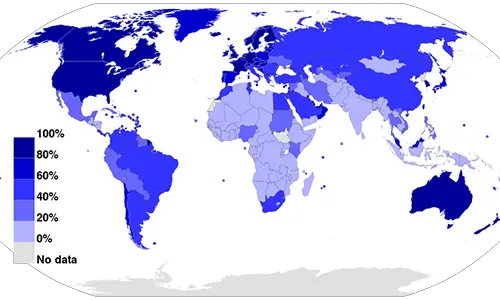Once, in the 1960s, there was Paul and there was Donald. They were independently doing their things. And when eventually their world met, they created something without which we could probably not even imagine a life. The Internet. When the ideas of Paul Baran at the Rand Corporation in the US and Donald Davis at the National Physical Laboratory in England met, they were dealing with what was then termed as packet switching. It was an experimental method for transmitting data across a network. Their combined efforts reached the Advanced Research Projects Agency Network (ARPANET), developed under the direction of the U.S. Advanced Research Projects Agency (ARPA). And then came the actual origin of Internet. But it was actually to establish a ‘certain superiority’ that drove many researchers like Paul and Donald to develop the Internet. In the 1960s, the US and USSR were considered supreme nations. So when the USSR launched Sputnik satellite in 1957, government investment for science and technology grew considerably in the US. And researchers had enough funds to pursue projects they deemed relevant to the US defense concerns. Over the years, the Internet has grown significantly and is still growing. And it remains a vast network of networks, not governed by a single person or group, but is the purest form of electronic democracy. Here are some facts about the Internet.
Fact 1: The first email message was sent by an engineer named Ray Tomlinson in 1971 over the ARPANET. In a later interaction he said, “The test messages were entirely forgettable…Most likely the first message was QWERTYUIOP or something similar…The first use of network email announced its own existence.”
Fact 2: Regarded as one of the founding fathers of the Internet and the architect of ARPANET, Lawrence Roberts was born to chemists in Connecticut. He built a high-powered transformer when he was eight. He earned his engineering degrees – bachelor’s, master’s and doctorate – from MIT. While doing so, he hacked into the New York City phone system to make free phone calls. Later, when ARPANET email system became popular, he got so addicted to it that he would carry a forty-pound Texas Instruments computer while traveling to check email in airports. But initially people were frustrated with email because of the unbroken screeds with no differentiation between messages. Roberts wrote the first email application, RD (short for Read) and revolutionized electronic communication by allowing users to file, save, delete, forward, reply to and organize their messages.
Fact 3: Think you can Google anything and find it. You may just be wrong. An estimate by Google itself states that Internet space might have 5 million terabytes of data (1TB = 1,000GB). It also states that the tech giant has indexed just 0.04%!
Fact 4: According to the Internet Society, penetration of Internet is the least in Myanmar (1.2%) and the most in Iceland (96.5%). UK is 11th, Canada is 15th and the US is 18th on the list. The Average Download Speed in Mbit/s is the most in Singapore at 97.67 and the least in Gambia at 1.35 Mbit/s. The US is placed 21st on the list with a download speed of 32.14 Mbit/s. The UK is 23rd and has a download speed of 29.34 Mbit/s while Canada is placed 34th with a speed of 24.23 Mbit/s.
Fact 5: The first web page on the internet was created by Tim Berners-Lee, a British scientist at CERN, who is credited to have invented the World Wide Web (WWW) in 1989. The address given was http://info.cern.ch/hypertext/WWW/TheProject.html. It was a page giving information on the World Wide Web project. In 2013, CERN reinstated the website to its original address.
Fact 6: Before he became the Vice Chairman of AOL, Ted Leonsis was credited to have sent the first AOL Instant Message. It was sent to his wife on January 6, 1993 saying, “Don’t be scared … it is me. Love you and miss you.” Skype got its first sentence in Estonian language in April 2003. It was sent by a member from the developing team and translated to “Hello, can you hear me?”.
Fact 7: From 1 in 1991, there are about a billion websites today. But according to NetCraft, in its October 2014 Web Server Survey, the number declined due to the monthly fluctuations accounted to inactive websites. Expectations are that the 1 billion mark will be breached by 2016.
Fact 8: As on June 2015, the Indexed Web contains at least 4.73 billion pages.
Fact 9: The first E-commerce trading happened in the 1970s itself. John Markoff, in his book – ‘What the Dormouse Said: How the Sixties Counterculture Shaped the Personal Computer Industry’, the world’s first online transaction was a drug deal! He writes – “In 1971 or 1972, Stanford students using ARPANET accounts at Stanford University’s Artificial Intelligence Laboratory engaged in a commercial transaction with their counterparts at Massachussetts Institute of Technology. Before Amazon, before eBay, the seminal act of e-commerce was a drug deal. The students used the network to quietly arrange the sale of an undetermined amount of marijuana.”
Fact 10: One of the first and most notorious cyber attacks took place in 1988. It was released by Robert Tapan Morris, who said that he was trying to find out the extent of the Internet. It was named the Morris Worm. It affected the nascent cyber infrastructure, especially of the US, making computers unusable. He was the first person to be convicted under the US’ computer fraud and abuse act. He now works as a professor at MIT.











Leave a Reply